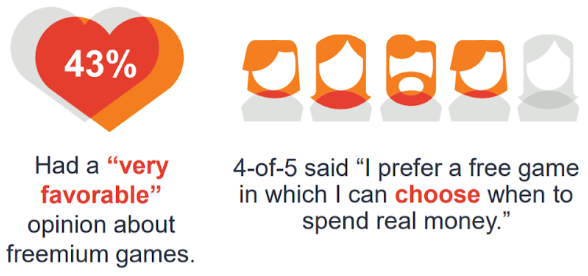Table of Content
In 2020, the number of apps available in the App Store and Play Store has reached 1.8 million and 2.8 million, respectively.
With the tremendous amount of competition, you just can’t stop at developing and publishing your app. Instead, you need to market it. Just like marketing a product, you need to follow a set of app marketing strategies to give your apps the popularity and desirability they deserve.
In fact, an app’s success heavily depends on how well it is marketed. In this article, we will cover the best app marketing strategies in 2020, for both iOS and Android apps, and look into why they work so well.
Research and Validate Your App’s Concept
Suppose you have a brilliant idea for an app. Before investing your time and money in developing it, you must ensure that the app you have in mind is one that people will look forward to using. One great way to do this is by asking your potential users. Post a poll in social media, and let the users decide whether they will enjoy using the app.
 A developer conducting a poll among users for a feature addition
A developer conducting a poll among users for a feature addition
The next thing to do is look at similar apps, and examine how hard the developers of those apps (your competitors) are working to impress the users.
Look For Similar Apps
By looking at similar apps, you can easily estimate the number of downloads and the revenue you can expect from your app. It is also a great way to validate your idea. Hit the App Store and Play Store with the keywords related to your app, and find the apps you will be competing with. If you find that there are tonnes of similar apps, it is better to reconsider your idea or develop an app with unique features that will help you stand out.
Find Your Competitors
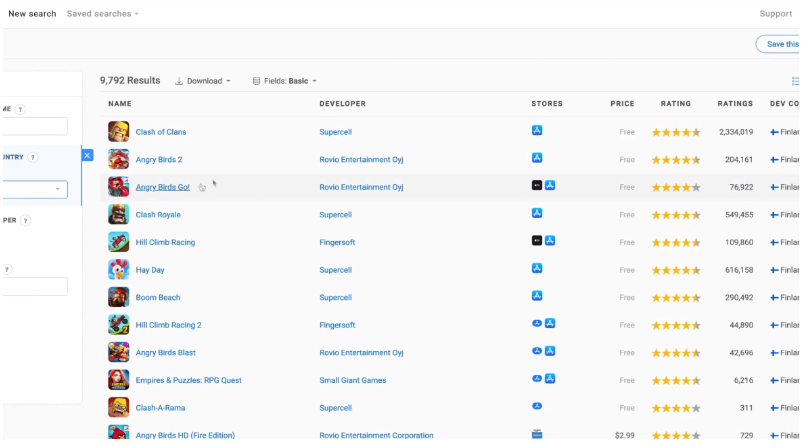 The app marketing tool AppFigures showing the competitors for the Game category. Image Credits: appfigures.com
The app marketing tool AppFigures showing the competitors for the Game category. Image Credits: appfigures.com
Knowing your competitors is essential for app marketing and to stay ahead of the game. The best way to do this is by using App Store Intelligence Platforms. These mobile app marketing tools will help you identify your competitors, their downloads, and other essential stats that will be useful for app marketing.
Here’s a list of some great platforms to get insights into your app competitors:
Review Mining
The best way to make your app stand out among your competitors is by including intriguing features. And the easiest way to identify these awesome features is through review mining. Review mining gives you a competitive advantage and a set of valuable data that can shape your app marketing strategies.
Here’s how.
Check Your Competitor’s App Store Reviews
Check the reviews of your competitors’ apps. Look at the good as well as bad reviews, and learn from both. Both the App Store and Play Store have one to five stars as rating parameters. So the first thing to do is look at the one and five stars reviews – this will give the bad and good aspects of your competitors’ apps.
Take note of where your competitors excelled and failed. Make sure these are reflected on your app development process. While this step has little to do with your mobile app marketing campaigns, it is a stepping stone to your app’s success.
Include Features the Users Want
 Adobe replying to a user’s suggestions on Adobe Spark’s cross-platform compatibility issues.
Adobe replying to a user’s suggestions on Adobe Spark’s cross-platform compatibility issues.
Reviews can be a gold mine because it provides information on the features your users want. Users might frequently be asking for certain features, which your competitors have failed to notice. You can include these features into your app, and use them for marketing and to show how your app is more beneficial to the users.
For making review mining easier, you can sort the reviews into categories.
In the App Store, you can sort the reviews as
- Most Recent
- Most Helpful
- Most Critical
- Most Favorable
In the Play Store, you can sort the reviews as
- Most Recent
- Most Relevant
- Positive
- Critical
You can also view the reviews of specific star ratings.
Interact With Users
One of the most important things to do before and after your app’s launch is to interact with the users consistently. You can do this both online and offline.
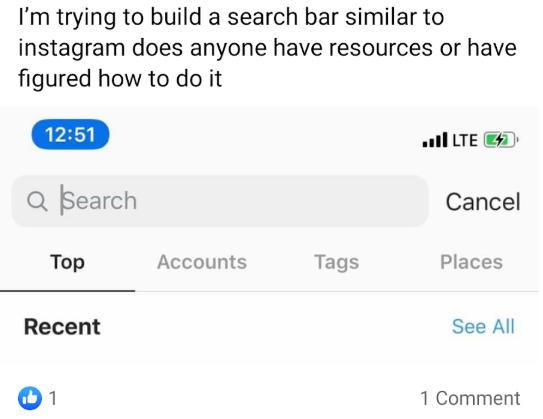 A developer asking for peer help to develop a feature.
A developer asking for peer help to develop a feature.
On social media, you can join groups of app entrepreneurs and marketers. This will help you gain more knowledge about tested strategies and what moves people. You can get into discussions about a particular feature you plan to implement and get insights on whether or not your users would welcome it. On the other hand, going to networking events will help you meet many like-minded people and give you an overview of how the industry adapts with changes.
People interaction is fruitful because it allows you to understand your users on a personal level and will also help you come up with mobile app marketing ideas.
Decide Your Revenue Model
Before looking into how to market an app successfully, you must choose the revenue model of your app. The revenue model is a crucial part of app marketing because it decides how you will compete with similar apps. If you make your app a paid one, and your competitor offers a free app, then chances are low for your app to gain a large user base.
Other than making your application a one-time paid app, there are several ways to monetize your app. Some of them are:
- Freemium Model
- Subscription Model
- In-App Advertising
- In-App Purchases
- Sponsorships
Around 72% of users found it to be okay to have in-app ads, in exchange for free app usage. If you wish to expand your app’s user base, then the freemium model or using in-app advertising is a great choice. You can include several app monetization strategies and generate ample income from it.
App Title and Description is Important
Your app’s ranking on the Play Store or App Store is determined by its:
- Title
- Description
- Reviews and Ratings
- Install Numbers
- Other stats like uninstalls and engagement
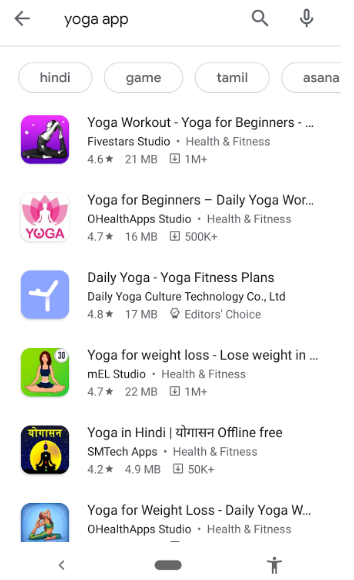 Searching “yoga app” in the Play Store gives this search result list
Searching “yoga app” in the Play Store gives this search result list
When a user searches for an app (for example, “yoga app” like in the above image), the search ranking algorithm matches it with apps that have the term “yoga” in it. So when you decide a name for your app, it is always better to include a keyword that relates to your app.
 The productivity app Forest uses a colon to include the keyword “focus”.
The productivity app Forest uses a colon to include the keyword “focus”.
If you want to stick to a particular name, yet rank up in the search results, it is better to use a hyphen or a colon and include a keyword – just like how the productivity app Forest did it.
Here are some tips that would help you in choosing your app’s name:
- Aim for uniqueness
- Include a keyword that is related to what your app does
- Make it concise, yet memorable
- Don’t use misspelt words (users will have a hard time finding your app, due to auto-correction in keyboards)
Your app’s description is equally essential for ranking high in the results page. Make sure you include the relevant keywords but never stuff it.
In the App Store, the first 2-3 sentences are the most important as they are visible to users without them having to tap on “..more”.
In the Play Store, performing rich formatting on the description using bullet points and paragraphs can make it easier for users to read. You can also use emojis to make the description more interactive.
Start Early
To get the most out of app marketing, you must start marketing as early as during the app’s development. Generate a buzz before pre-launch. Give a glimpse or sneak-peek of your app’s features to your users. Use social media and email lists to let the world know that your app is on its way. Do note that the Android app marketing strategy and iOS app marketing strategy are similar, except when it comes to App Store Optimization (ASO).
 The upcoming productivity app Steno Notes offers early access to Android users
The upcoming productivity app Steno Notes offers early access to Android users
 Appcompanist, a practice app for singers, updates their social handles whenever they add a new feature to their app.
Appcompanist, a practice app for singers, updates their social handles whenever they add a new feature to their app.
 Gameloft’s website collects emails from users to send their newsletters.
Gameloft’s website collects emails from users to send their newsletters.
Feedback and Response From Developers
Getting input from the developers is a great way to perfect your app. There will be several overlooked functionalities that would require tweaking to make them better. A user will most probably look at the UX of your app. In contrast, a developer will point out the flaws in design and development. Developers can offer insights on how to frame an effective app marketing strategy as well.
In-App Marketing Strategies to Perform
If the app you are trying to market is poorly developed, the entire effort in app marketing will become futile. You need to perfect the app as much as possible. Here’s how.
Catchy App Icon
The first thing users notice about your app is its icon. Make sure the design of your app’s icon reflects what your app does, and at the same time, impress the viewers enough to try it out. App icon updates are the second most frequent form of ASO.
 Experiment with the design – use A/B testing. See which icon design brings in more downloads. Image Credits: 9to5mac.com
Experiment with the design – use A/B testing. See which icon design brings in more downloads. Image Credits: 9to5mac.com
Some tips to make a great app icon:
- Don’t use words in it
- Consistency is the key – If you have several apps with the same concept, try to keep the design similar
- Use borders – this would make the icon stand out in any background
User Experience (UX)
Undoubtedly, the user experience forms the foundation of your app’s success and plays a crucial role in app marketing. Make sure your app is easy to interact with. If your users find the experience they seek within your app, they are more likely to recommend it to their friends.
 Duolingo, the language learning app, makes learning fun and easy with innovative UX.
Duolingo, the language learning app, makes learning fun and easy with innovative UX.
An excellent example of intriguing UX is the language learning app Duolingo. Although learning a language can be a troubling experience, Duolingo turns it into a game. Its UI is excellent, and never leaves the users confused.
Design
Creating memorable app designs is a great way to retain users. The design is one way your users will remember the app. Give attention to the small details – try including charming sounds and transitions that users will find enjoyable.
Make sure the design is optimized for all devices. Also, ensure your app looks consistent on both the iOS and Android platforms. This would be helpful for your users migrating from either platform.
Push Notifications
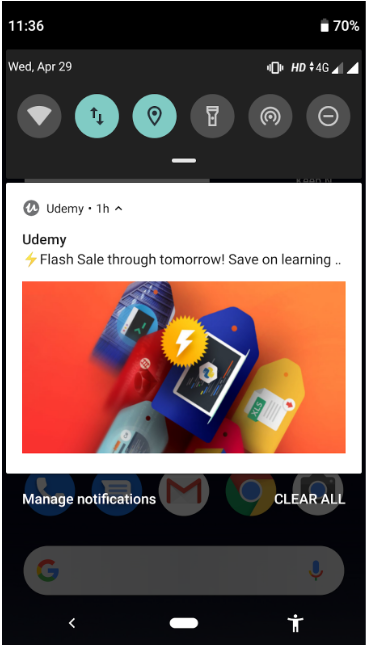 Udemy updates its users with push notifications about events and promotions.
Udemy updates its users with push notifications about events and promotions.
Push notifications can significantly improve the engagement rates of your app – but don’t be too pushy. Several users might have installed your app and forgot about its existence. Push notifications can remind them about your app.
Some great things to do with push notifications are:
- Personalise the notifications with the user’s name
- Display real-time information
- Send info on offers and promotions
Push notifications are 7X times more likely to be opened than an email. Also, with segmentation, push notifications can increase retention rates up to 93%.
Do note that the usage of push notifications differ in iOS app marketing and Android app marketing, considering the differences in the OS environment and user behaviour (will be discussed later).
Make Your Users Market Your App
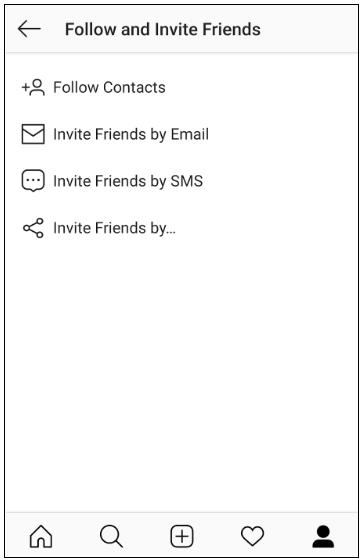 Instagram offers social sharing buttons, allowing users to share the app.
Instagram offers social sharing buttons, allowing users to share the app.
In app marketing, nothing can beat the power of the word of mouth (WOM). In most cases, people start using an app solely because someone recommended it to them. A person recommending your app is a loyal customer of your app.
A person tends to recommend an app only when they find it usable or enjoyable. If you respond to your users’ needs correctly and update your app with improved functionalities, they will stick to your app and bring their friends as well. Make sure you have clear social share options within your app to let your users spread the word.
Customer Feedback and Reviews
A majority of apps lose users when they fail to listen to them. Just as you review mine your competitors, you should frequently look into what your users are saying.
 The mobile app from Wix allows users to send feedback in-app.
The mobile app from Wix allows users to send feedback in-app.
Make sure there’s a section within your app that lets users send their feedback and don’t forget to respond to them. If you don’t, users are more likely to post their issues as reviews on the app store – which is highly unfavourable.
Reviews in App Store
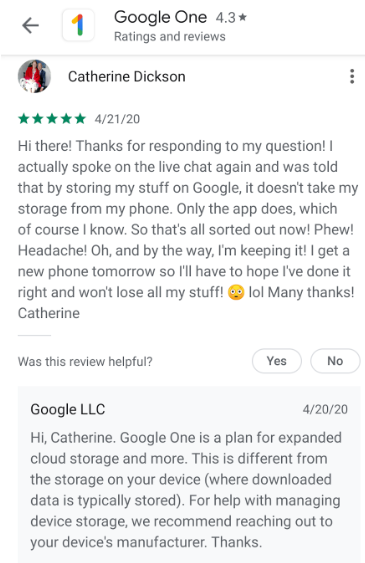 Google responding to a user review of the Google One App
Google responding to a user review of the Google One App
Replying to each review on the App Store or Play Store is an excellent gesture that many users will appreciate. These might be requests for better features or recognition of your efforts. Either way, respond to them without fail. Some users might intentionally place false reviews to tarnish your app’s reputation. Keep a check on them, and ensure you remove them.
Also, most users don’t put reviews unless you prompt them to do it. Remind them..
Analytics
If a user downloads your app and keeps it unopened, then you lose – it is just like uninstalling your app. For this, closely monitoring the analytics of your app is vital to understand how users are using it. Luckily, both the App Store and Play Store offer insightful analytics.
 The App Store Connect showing the user trends for an app. Image Credits: twitter.com
The App Store Connect showing the user trends for an app. Image Credits: twitter.com
For example, if the analytics reveals that users stick on to your app after the fourth day of installing it, it would be a good idea to initiate engagement strategies to retain them.
Here’s a list of some mobile app marketing tools useful for analysing user behaviour in your app:
Ad Exchange
If you have a limited budget for app marketing, ad exchanges are a great option to consider. With ad exchange you can collaborate with other developers to display your app’s ads on their apps, in return for displaying their advertisements on your app. While choosing your collaborators, make sure you get the same number of app installs that you can provide them with.
Building Your App’s Online Presence
Relying solely on the app stores for your app to be found won’t gather the traction it deserves. Instead, you need to take your app and market it where your users hang out online. In most cases, an app succeeds when it is successful in building a community around it. This means increasing your app’s online presence. Let’s look at how it’s done.
Website
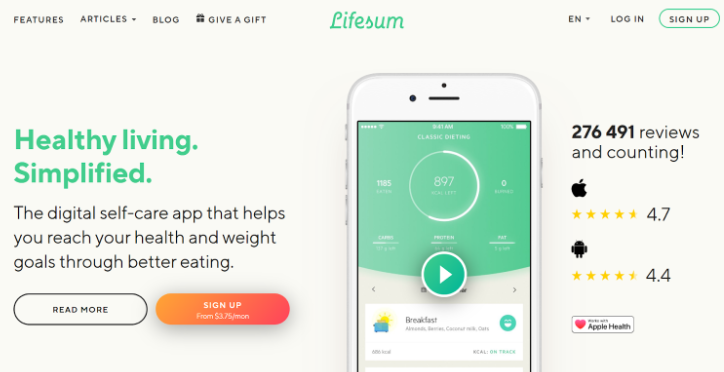 The fitness app Lifesum offers info on the app’s along with a call-to-action (CTA) on their website.
The fitness app Lifesum offers info on the app’s along with a call-to-action (CTA) on their website.
It is always better to launch your website as early as your app’s development phase. Even if you don’t spend much time or effort into it, having a basic set of features would do. You can use the website to display the features of your app. You can even include a countdown in your site if your app is yet to be launched.
Start basic and add more features as you progress. Make the website’s content easy to read with lots of white space. Users must be able to easily navigate through the features of your app and be led to a CTA to download the app.
Here are some must-haves in your website:
- An excellent landing page with info on your app and its features
- App screenshots
- App promo videos showing your app’s interface
- Subscriptions form if your app is in development
- User reviews
- Links to your other apps, if any
- Download links to the app stores using store badges
- Contact info – make it easier for your users to reach you
Blog
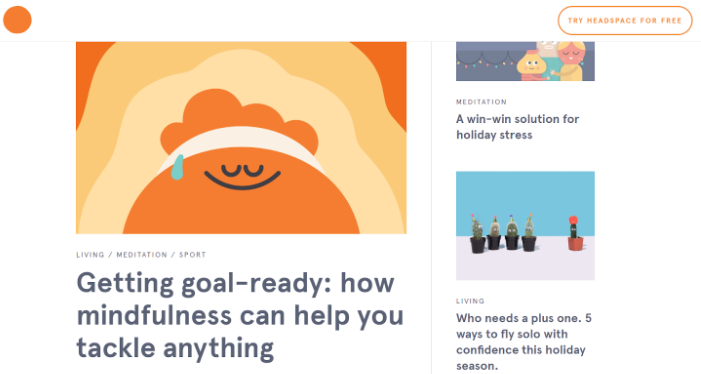 Headspace uses their blogs to discuss the mindfulness resulting from meditation, which is the unique selling poing (USP) of their app
Headspace uses their blogs to discuss the mindfulness resulting from meditation, which is the unique selling poing (USP) of their app
Blogs are an excellent way for organic app marketing. You could easily add blogs as a section within your website. If you are still in the development phase, you can update your blogs with the progress of your app’s development. If your app is online, you can blog about the feature updates.
Another way to use blogs for app marketing is by talking about an issue (something that bothers users) and explain how your app solves the problem. You can also produce content within your app’s niche, aimed at educating your readers (and wittily introduce your app into it). For example, if you have a productivity app, you can post blogs about tips to improve productivity.
Social Media Marketing
Think of a room where all of your potential customers are always present. Yes, that’s social media. While blogs would require users to search, using social media, you can present your apps in front of the users. How well you present your app determines downloads and user engagements The best places to start:
- Quora
- YouTube
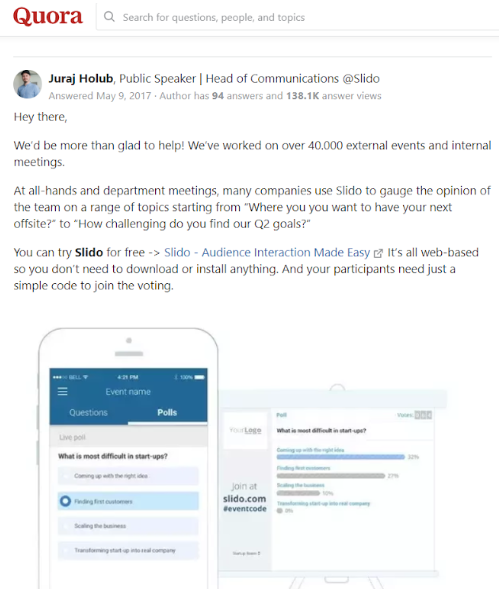 The Online poll app Slido is promoted in Quora as an answer to a user’s question “What are the best poll apps?”
The Online poll app Slido is promoted in Quora as an answer to a user’s question “What are the best poll apps?”
 Lumosity uses Facebook to offer audience free unlocks of specific features of their app.
Lumosity uses Facebook to offer audience free unlocks of specific features of their app.
 Netflix uses Instagram to engage their users through posting scenes from TV shows
Netflix uses Instagram to engage their users through posting scenes from TV shows
 EA Games uses YouTube to display their gameplays.
EA Games uses YouTube to display their gameplays.
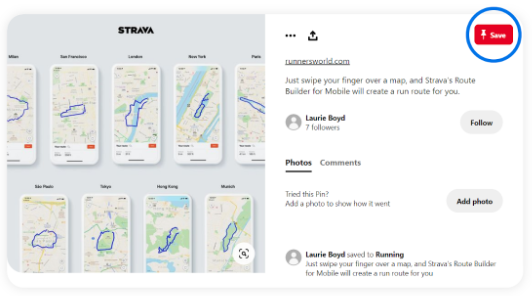 Screenshots of route maps from the fitness app Strava is shared in Pinterest
Screenshots of route maps from the fitness app Strava is shared in Pinterest
Email Marketing
 The language learning app Duolingo uses email marketing to bring unengaged users back to the app.
The language learning app Duolingo uses email marketing to bring unengaged users back to the app.
Email marketing is a hidden gem mostly overlooked in app marketing. The email list collected from your app as well as your website is an excellent method to improve user retention. Marketers who used segmented email campaigns witnessed as much as 760% increase in revenue.
Using email marketing, you can send:
- Info on in-app purchase discounts
- Reminder of events
- Weekly newsletter with your blog updates
The possibilities are endless.
Video Marketing
Grammarly uses video to show the benefits of using their app for increasing productivity.
Video is the most effective and extensively used form of media in a content strategy. Video content is 12 times more likely to be shared than other formats. You can incorporate video into your social media strategies and gain better followers. With video marketing, you can perform the following:
- Promo videos of your app’s benefits
- Display your app features with convincing visuals
- User generated content (UGC) as reviews
App Store Optimization (ASO)
App Store Optimization (ASO) is the process of optimizing an application for gaining maximum visibility in app stores during Search (when a user searches) and Explore (when a user browses). The best ASO practices can maximise the number of organic downloads without spending too much on user acquisition.
What Are the Benefits Of ASO?
The number of downloads of an app is directly related to its position in the search results – the higher, the better. Most users find apps through Search in app stores. If you want your app to be readily available through search, then ASO is a must. Also, properly executing ASO is one of the most useful app marketing strategies. Here are some of the many benefits of ASO:
- Improving visibility and helping your users find your app with ease
- Match your app with relevant keywords, which would help users who are looking for apps of your niche
- Increase organic downloads
- Reduce user acquisition cost
- Get more users across different countries using localization (will be discussed later)
ASO for App Store and Play Store are similar to an extent. What differentiates their ASO are factors like character limit, and the impact of specific components on search. In short, the Play Store views ASO more close to SEO than the App Store does. Just like the importance of keywords for SEO in google search, Play Store too gives importance to keywords. In contrast, using keywords in descriptions in the Apple App Store has no impact on search.
Ranking Factors for App Store:
- App Name
- App Subtitle
- App URL
- Keyword Field
- Download and Engagement
- Updates
- Ratings and Reviews
- In-App Purchases
Ranking Factors for Play Store:
- App Name
- App Description
- Backlinks
- Downloads and Engagement
- Updates
- Rating and Reviews
- In-App Purchases
Do note that ASO is not just about Search. Let’s look at how to market an app using ASO.
- Choose a set of keywords for your app to be found. Keywords must include:
- Main app features along with synonyms
- App’s category
- Terms users use to describe this category
- Fill in the App title and Description as discussed before. The Play Store allows 50 characters in the title and 4000 characters in the description. The App Store allows 30 characters in the title and 4000 characters in the description. Try to include keywords in your app description, especially for Play Store
- Find the perfect app icon using A/B testing
- Include insightful screenshots and videos
- Respond to your reviews
ASO is a never-ending process in app marketing. It can’t be left unattended for too long. The best way is to keep on tweaking with the components of your app page. Also, perform A/B testing for the description and keywords to find the best combination that brings in the most downloads.
While performing ASO, keep in mind that the optimization is not just for the ranking algorithm. It is for the user as well. How informative and relevant your description is to the user will ultimately decide your app’s success.
Here’s a list of some mobile app marketing tools for ASO and keyword research:
App Store Localization
 Including multiple languages in App Store Connect for localization.
Including multiple languages in App Store Connect for localization.
Localization is an integral part of ASO that customises your app page for other languages. This will help your app rank higher in search results in countries where users use a different language to search. It is observed that localization boosted app downloads by 300%.
In the App Store, you can localize into 40 different languages. In the Play Store, you can localize into 77 different languages.
While performing localization in the Play Store, make sure you uncheck auto-translation.
You must localize:
- Keywords and text
- Video content
- Screenshots
- App Previews
Get Featured in the App Store
Getting featured in both the Apple App Store and Google Play Store is a prestigious recognition for your app. For your app’s exceptional build and user experience, your app has been selected and suggested to users.
Getting featured brings in more visibility, downloads and credibility as your app has been closely monitored by the experts in the app stores. In the App Store, a featured app comes under the Featured category, whereas in the Play Store it is shown as Editor’s Choice.
How To Get Your App Featured in the App Store?
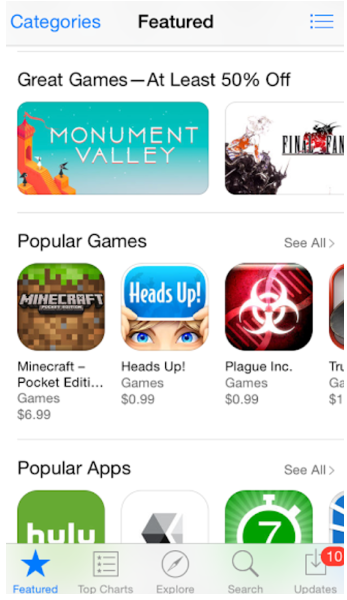 Apps under the Featured Category in the Apple App Store
Apps under the Featured Category in the Apple App Store
- Design interactive UI and intuitive UX
- Perform app localization and ASO
- Use Apple’s API
- Update your app frequently with exciting features
- Improve your app’s accessibility, according to Apple’s accessibility guidelines
- Fill the Get Featured on App Store form
How To Get Your App Featured in the Play Store as Editor’s Choice?
 Apps under the Editor’s Choice in Google Play Store.
Apps under the Editor’s Choice in Google Play Store.
- Maintain your app’s quality
- Make it seamlessly accessible across all Android devices (tablets, TV, wearables)
- Make use of the developer tools from Google to make your app robust
- Follow the Android App Launch Checklist
- Design according to Google’s Material Design
- Perform Store Listing Experiments
- Perform app localization and ASO
- Pitch your app to high-traffic sites like Android Authority, Product Hunt, TechCrunch, and Android Central to get noticed by Google
- Use Google as your payment provider and never make your app download other apps
Get Featured in Mobile App Review Sites
 TechCrunch featuring the streaming app Sonos Radio
TechCrunch featuring the streaming app Sonos Radio
To get featured on an app review site, you need to pitch them your app’s concept. Along with that, your app must have the following:
- Impressive UI and UX
- Unique contents
- Stability with no bugs or glitches
While pitching your app to a review site, make sure you include the following:
- Link to your app in the app store
- A concise paragraph describing your app and why it stands out
- Screenshots of your app including in-app content, logo and title screen
- Links to videos of your app, if any
- A promo code to use your app for free, if it’s a paid one
Here’s a list of some app review sites:
If you get featured on an app review site, you can expect tons of app downloads.
Influencer Marketing
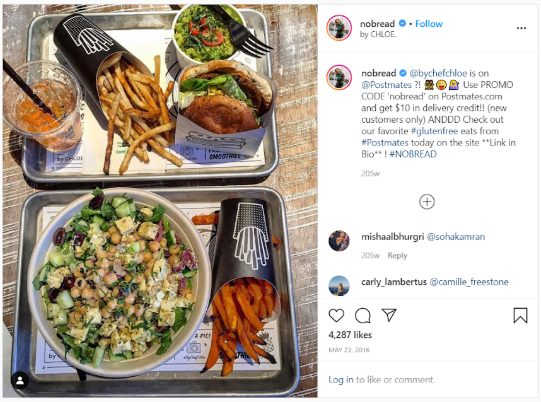 Instagram Influencer Nicole Cogan promoting the app from Postmates.com with a specialised discount coupon
Instagram Influencer Nicole Cogan promoting the app from Postmates.com with a specialised discount coupon
Influencers can drive app installs significantly by improving your app’s desirability and awareness among new users. The best way to do this is to find influencers within your app’s niche. For example, if your app is a home workout app, connect with a fitness influencer and pay them to promote your app. YouTube, Facebook and Instagram are great platforms for influential marketing. You can use Deep Links (discussed later) and even offer discount codes through these influencers for in-app purchases.
Apply For App Awards
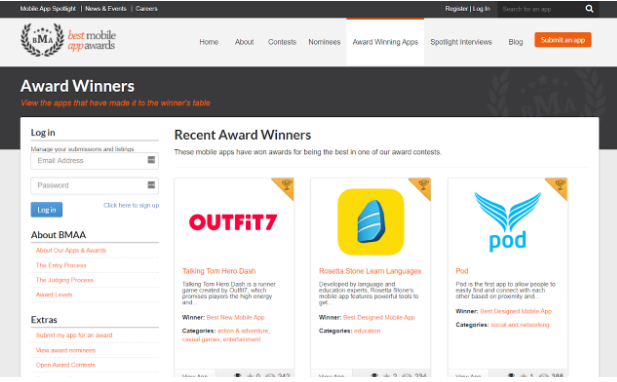 Bestmobileappawards.com displaying their app award winners.
Bestmobileappawards.com displaying their app award winners.
Participating in app awards can bring in lots of exposure, downloads and reviews for your app. Although winning an award entirely depends on your app’s concept and the way you pitch it, if you do it right, app awards can give your app the success it deserves. Here are some great app awards sites:
Paid App Install Ads
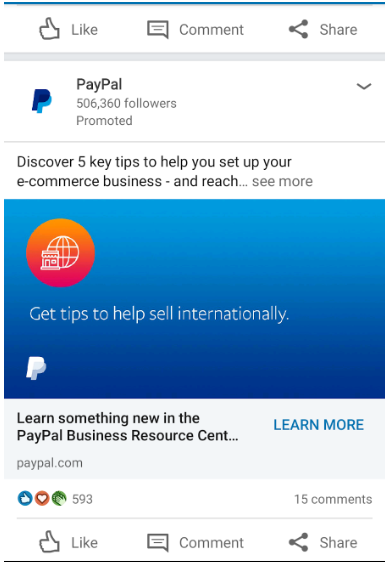 PayPal’s app install ad in LinkedIn
PayPal’s app install ad in LinkedIn
Paid ads are becoming an increasingly popular app marketing strategy for driving app installs. You can highlight the key features of your app and combine it with witty copies to impress your users and increase app installs.
You can run your paid ads in social media, search engines and even consult with mobile app advertisers. Both the App Store and Play Store allow app install ads to drive better installs.
Deep Linking
Deep linking is a relatively new term in app marketing, but it is becoming important. In simple terms, deep linking bridges the gap between web and mobile apps. When a user browses the internet using a phone, a Deep Link can send the user directly from the web to the specific content in an app. For example, if a user searches for a location in an Android browser and clicks on the Direction button, the user is redirected to Google Maps with the location entered.
Another advantage of Deep Links is that even if a specific app isn’t installed on a user’s device, they can be prompted to install it.
We have also written an article on mobile retargeting and deep linking.
Cross-Promotion
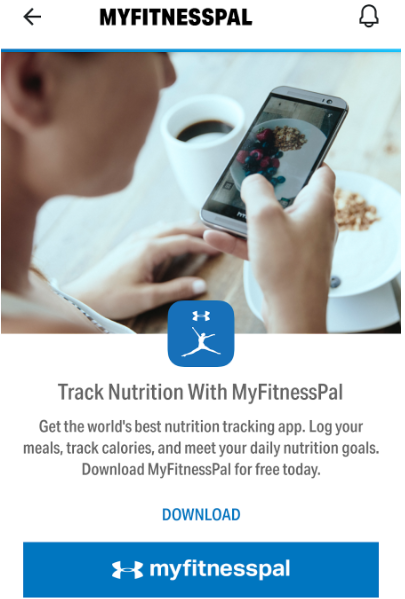 Fitness app MapMyRun cross-promoting MyFitnessPal app from the same publisher.
Fitness app MapMyRun cross-promoting MyFitnessPal app from the same publisher.
You probably won’t stop with releasing just one app. If you have more than one app, you can use it to cross-promote other apps. If all your apps are within a niche, then chances are high you will gain better installs if you cross-promote. If this is your first app, you can ask other fellow developers to help you with the promotion.
Regularly Roll Out New Updates
Keeping your app updated is a great sign that shows your commitment to it as a developer. It can improve the features of your app, help you stay relevant with changing trends and add more features the users want. With growing concerns for security, updates can make your app secure and free from bugs.
Retain Existing Users
Keeping your existing users is as important as acquiring new ones. While the engagement rate of an app is highly dependent on the relation that it has to a user’s daily life, there are several ways you can draw users’ attention to your app. Here are some ideas:
- Make the sign-up or login process easier
- Send personalised push notifications
- Use social media and email marketing
- Give users loyalty rewards
- Be open to users’ feedback
iOS and Android Users Behave Differently
There’s a considerable difference in users’ behaviour while using the iOS or Android Operating Systems. As an app developer or marketer, you must know the difference for effective app marketing. The difference is based on the user experience each OS offers, which further shapes the users’ expectations of how the OS will behave.
In simpler terms, the user experience would decide how the users engage and make choices within the OS.
Here’s how:
- Nearly 3.5% of Android users and 1.8% of iOS users open push notifications.
- It takes an iOS user on an average 7 minutes to open a notification, compared to the 48 minutes taken by an Android user.
- An iPhone user spends twice as much as an Android user, even though android apps have far more downloads
- iPhone users are more inclined to make a purchase using their phones.
In short, an average iOS user is more active than an average Android user. When performing both iOS app marketing and Android app marketing, you must keep these stats in mind to channel your resources the right way.
Final Thoughts
App marketing is a never-ending process that requires frequent tweakings. It is better to start marketing your app while it is being developed.
You can’t define a set of app marketing strategies that would work for all apps. This is because each app differs in its very nature, and so must be marketed accordingly. The key is to be consistent with app marketing. Remember to perform A/B testing with each component.


